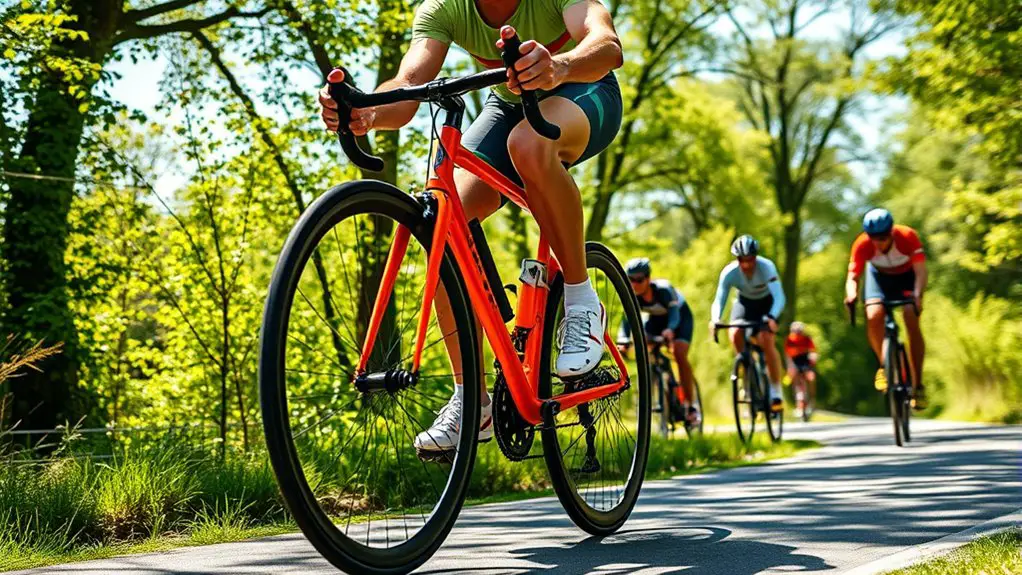Hamstring flexibility directly impacts your running speed because it enhances stride efficiency. When your hamstrings are flexible, you can achieve longer strides without losing control. This elasticity allows for better energy storage and release during push-offs, making each step more powerful. Conversely, tight hamstrings can lead to imbalances and inefficient running mechanics, increasing your risk for injury. By improving your flexibility, you can enjoy faster, smoother runs. Discover techniques to enhance your hamstring flexibility and performance further.
Understanding Hamstring Anatomy and Function
The hamstrings, a group of three muscles located at the back of your thigh, play an essential role in your overall mobility and athletic performance. Understanding their structure and muscle function is key to releasing your body's potential. These muscles consist of the biceps femoris, semitendinosus, and semimembranosus, working together to enable hip extension and knee flexion.
When you run, strong and flexible hamstrings allow for a full range of motion, contributing to powerful strides. If these muscles are tight or weak, it can limit your speed and increase the risk of injury. By prioritizing hamstring health, you not only enhance your performance but also gain the freedom to move with confidence. Incorporating strengthening exercises and keeping your hamstrings in check can lead to a more dynamic and fulfilling running experience. Embrace this knowledge, and you'll feel the difference in every stride.
The Connection Between Flexibility and Stride Length
When you consider the mechanics of running, flexibility plays an essential role in determining your stride length. If you're looking to maximize your speed, understanding this connection is key. Here's how flexibility impacts your stride mechanics:
- Increased Muscle Elasticity: Flexible muscles can stretch and contract more efficiently, enhancing your stride.
- Optimal Range of Motion: Greater flexibility allows for a fuller range of motion, enabling longer strides without sacrificing control.
- Improved Power Generation: Elastic muscles store and release energy effectively, contributing to more powerful push-offs.
- Reduced Energy Waste: When your muscles are flexible, you use less energy to maintain your stride, allowing for sustained speed over longer distances. Additionally, core strength is essential for stabilizing the body during running, which further enhances overall performance.
How Tight Hamstrings Increase Injury Risk
Tight hamstrings can greatly elevate your risk of injury, especially when running. When your hamstrings are stiff, they can create muscle imbalances that lead to poor running mechanics. This imbalance doesn't just affect your stride; it puts extra strain on your knees and lower back, increasing the likelihood of hamstring injuries. If you're pushing your limits without proper flexibility, you might find yourself sidelined by pain and setbacks.
Moreover, tightness in these muscles can restrict your range of motion, making it harder to achieve an efficient running form. As you run, the lack of flexibility forces your body to compensate in ways that can lead to overuse injuries. So, if you want to keep enjoying the freedom of running, it's essential to pay attention to your hamstring flexibility. Prioritizing this can help you avoid injuries and keep you on the path toward your running goals. Additionally, proper warm-ups help prepare muscles for activity and reduce the risk of injury.
Techniques to Improve Hamstring Flexibility
Improving your hamstring flexibility is essential for enhancing your running performance and reducing injury risk. Here are some effective techniques you can incorporate into your routine:
- Static Stretches: Focus on holding hamstring stretches for 20-30 seconds post-run to lengthen the muscles.
- Dynamic Stretches: Incorporate leg swings and walking lunges before your runs to activate and loosen the hamstrings.
- Foam Rolling: Use a foam roller on your hamstrings to release tension and improve blood flow, promoting flexibility.
- Yoga Poses: Integrate poses like Downward Dog and Forward Bend to deepen flexibility and strengthen the hamstrings.
Additionally, don't forget about strength training and mobility drills, which can enhance overall muscle balance and support flexibility improvements. By consistently using these techniques, you'll not only enjoy greater freedom in your runs but also stay injury-free while boosting your speed. Moreover, incorporating mobility training into your routine can further enhance your overall performance and reduce injury risk.
Real-Life Benefits of Enhanced Flexibility for Runners
Enhanced hamstring flexibility can greatly impact your running experience, as it not only boosts your speed but also reduces the likelihood of injuries. When you're more flexible, you can enjoy longer runs without the nagging tightness that can slow you down. Incorporating dynamic stretching into your warm-up routine helps activate your muscles and prepares them for action, allowing for a smoother stride.
Additionally, using foam rolling techniques can aid in muscle recovery, easing tightness and enhancing overall flexibility. This means you'll bounce back quicker after workouts, giving you more opportunities to hit the trails or track without fear of injury. With improved flexibility, you'll feel freer and more fluid in your movements, leading to a more enjoyable and fulfilling running experience. So, embrace these methods, and watch as your runs transform into a liberating expression of speed and agility. Moreover, prioritizing adequate muscle recovery through proper nutrition and hydration can further enhance your performance and resilience on the track.
Frequently Asked Questions
How Can I Tell if My Hamstrings Are Tight?
Ever wondered if your hamstrings are tight? A simple hamstring assessment can help. Try flexibility tests like the standing toe touch or the seated reach. If you struggle to reach your toes or feel discomfort, your hamstrings might be tight. This tightness can limit your movement and freedom during activities. Keeping your hamstrings flexible can enhance your comfort and performance, so it's worth checking in on them regularly.
Do Genetics Affect My Hamstring Flexibility?
Yes, genetics can definitely affect your hamstring flexibility. You might have a genetic predisposition that influences how flexible your muscles are compared to others. This means that some people naturally have more flexibility variations, while others may struggle with tightness. However, it's important to remember that regardless of your genetics, you can still work on improving your flexibility through targeted stretching and exercises. Embrace your journey towards freedom in movement!
Can Age Impact Hamstring Flexibility?
Absolutely, age can impact your hamstring flexibility. As you get older, age-related changes can affect your muscle elasticity, making it harder to maintain that freedom of movement you crave. Your muscles may not stretch as easily, which can lead to stiffness. Incorporating regular stretching and mobility exercises can help combat these changes, keeping you feeling agile and ready to take on whatever activities you love, regardless of your age.
How Often Should I Stretch My Hamstrings?
Studies show that athletes who incorporate both static and dynamic stretching regularly can improve their flexibility by up to 20%. To keep your hamstrings in top shape, aim to stretch them at least three times a week. Dynamic stretching is great as part of your warm-up, while static stretching works well post-workout. Listen to your body, and don't hesitate to adjust your routine for maximum freedom and comfort in movement.
Are There Specific Foods That Help Improve Flexibility?
Yes, there are specific foods that can help improve your flexibility. Focus on nutrient-rich foods like leafy greens, nuts, and fruits, which provide essential vitamins and minerals. Staying hydrated is also key; water helps maintain muscle elasticity and joint lubrication. Incorporating these foods into your diet can give you the freedom to move more easily and perform better. So, grab those nutrient-dense snacks and keep that water bottle handy!




